Inflammatory Bowel Disease

What is Inflammatory Bowel Disease (IBD)?
Inflammatory Bowel Disease (IBD) is a gastrointestinal (GI) disorder that involves long-lasting inflammation of your digestive tract. Although IBD is commonly considered a disease of young adults, it can occur at any age. There is a first peak onset of IBD at 15-30 and a second peak at 60-70. Patients aged over 60 account for up to 35% of all IBD cases in Europe and incidence is rising.
There are two main types of IBD:
- Ulcerative Colitis (UC), which only affects the large intestine
- Crohn’s Disease (CD), which can occur anywhere in the GI tract between the mouth and anus
Although the exact cause of both UC and CD is still unclear, it is known that it involves a complex interaction between four factors:5
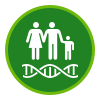
Genetics (family history)

The environment (e.g. a certain diet and lifestyle over a long period of time)

The immune system

Bacteria that live in the gut
None of these factors alone are likely to cause the disease.
Although both forms of IBD share many similarities, there are also some important differences such as the symptoms they cause.
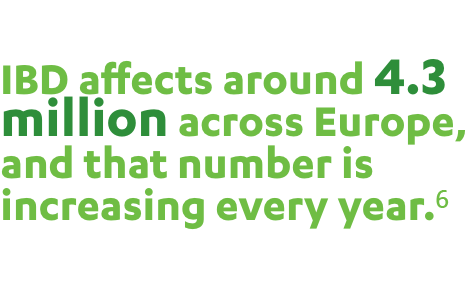
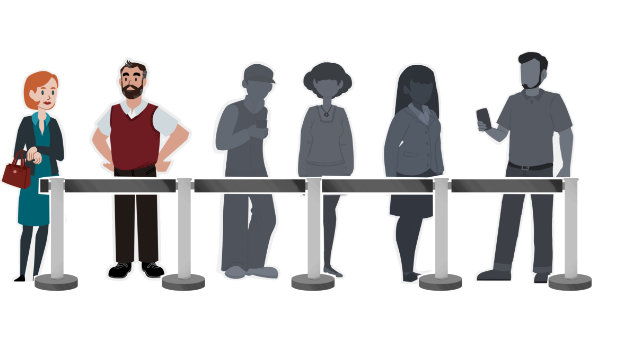
Watch the video 'My IBD Journey: Life after diagnosis' which offers practical advice on positive steps you can take following an IBD diagnosis and how to live well.
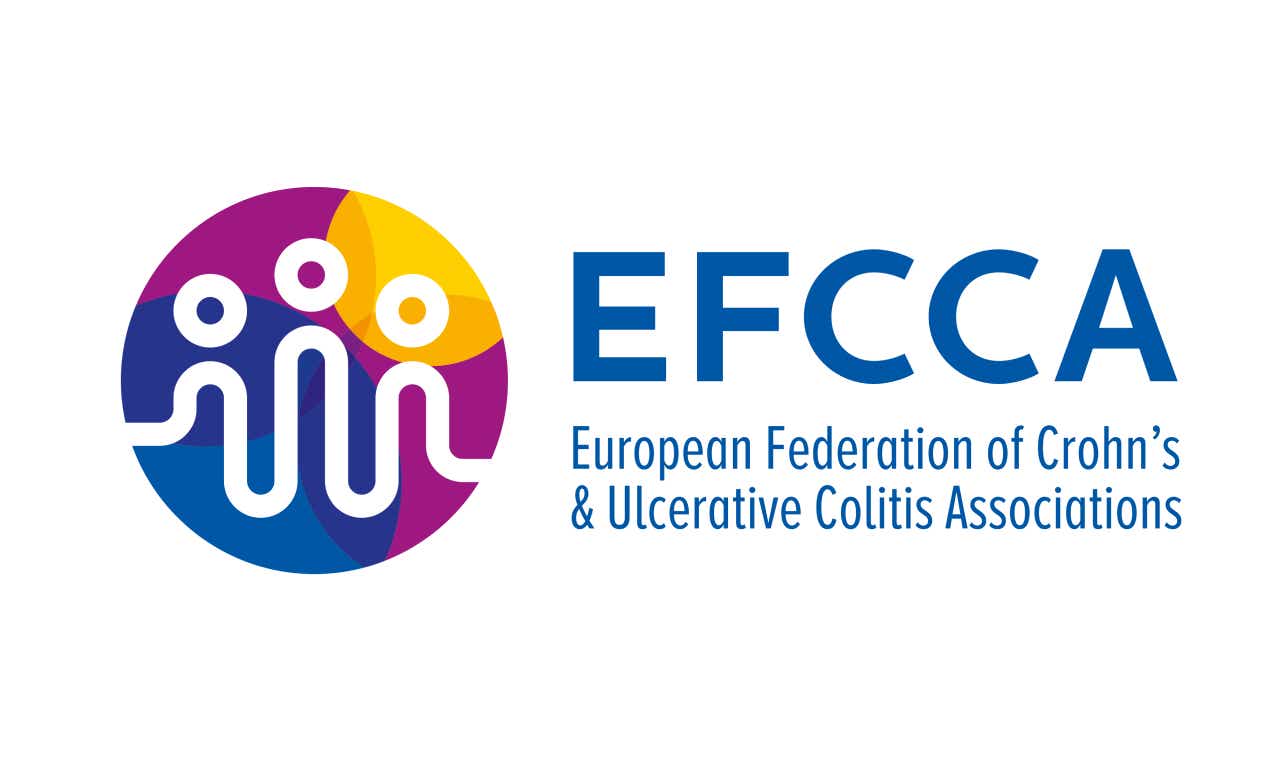
IBD affects around 4.3 million across Europe, and that number is increasing every year.6
The European Federation of Crohn's & Ulcerative Colitis Associations (EFCCA) is an umbrella organisation representing 45 national Crohn’s and Ulcerative Colitis (collectively known as IBD) patient associations.
What are the symptoms of Ulcerative Colitis (UC) and Crohn’s Disease (CD)?
Symptoms of IBD can come and go, sometimes without warning, and can be caused by triggers such as certain foods or stressful situations, which will be different for each person living with IBD. When the inflammation worsens, and you experience more symptoms of your condition, it is called a ‘flare-up’. The quiet or symptomless period of time between flare-ups is called ‘remission’. In children, IBD can be more severe than in adults, and can have different effects such as delayed puberty and growth rate impairments.789
Please click on the relevant icon for symptoms of each specific condition:
Ulcerative Colitis (UC)
- The symptoms of Ulcerative Colitis (UC) depend on the severity and extent of the disease, as well as on which part of the colon is affected10
- The likelihood of developing UC is almost the same for women and men and is thus not linked to biologic gender11
- For most people living with IBD, the disease begins at an early age, but people can also develop UC at an older age12
- The main symptoms of UC are:101213
- Diarrhoea
- Rectal bleeding – visible blood in the stools
- Urgency to defecate
- Inability to defecate despite urgency
- Fever
- Weight loss
- Tiredness
- Abdominal pain
However, the symptoms that occur in people with UC are very diverse. At the beginning of the disease, there may only be unspecific symptoms in the gastrointestinal area that seem harmless. If they occur more frequently and with increasing intensity, they can also be serious signals of IBD. Some people may also develop a low number of red blood cells (anaemia) or problems with their joints, skin and eyes.13
Remember to always talk to your doctor to get advice if you are experiencing symptoms, especially if there has been a sudden change.
For further information on symptoms, please visit the Managing IBD page.
Crohn’s Disease (CD)
- The symptoms of Crohn’s Disease (CD) depend on the part of your digestive tract that is affected by the disease and severity14
- The likelihood of developing CD is almost the same for women and men and is thus obviously not linked to biologic gender
- For most people living with IBD, the disease begins at an early age but people can also develop CD at an older age14
- The main symptoms of CD are:131415
- Stomach pain
- Fever
- Diarrhoea with blood and/or mucus and/or pus
- Bowel obstruction
- Fatigue (tiredness)
- Weight loss
However, the symptoms that occur in people living with CD are very diverse. At the beginning of the disease, there may only be unspecific symptoms in the gastrointestinal area that seem harmless. If they occur more frequently and with increasing intensity, they can also be serious signals of CD. Some people may also develop a low number of red blood cells (anaemia) or have problems with their joints, skin and eyes.13
Remember to always talk to your doctor to get advice if you are experiencing symptoms, especially if there has been a sudden change.
For further information on symptoms, please visit the Managing IBD page.
What are the types of Ulcerative Colitis (UC) and Crohn’s Disease (CD)?
IBD is a complex and heterogeneous set of diseases.16 IBD will be different for each person living with it including the symptoms, severity and causes of flare-ups which making IBD a very complex condition.16
Please click on the relevant icon for each specific condition for more information:
Ulcerative Colitis (UC)
There are different types of UC, depending on what part of the colon is affected. The most common types are:13
- Ulcerative proctitis: Bowel inflammation confined to the rectum (last part of the large intestine that terminates in the anus)
- Left-sided colitis: Continuous inflammation that begins at the rectum and extends to the splenic flexure of the person’s colon (a bend in the colon near the spleen). This condition also includes proctosigmoiditis, that affects the rectum and what is called the sigmoid colon, the lower end of the colon
- Extensive colitis: Continuous inflammation that begins at the rectum and extends beyond the splenic flexure
Crohn’s Disease (CD)
There are different types of CD, depending on what part of the GI tract is affected. Sometimes it can affect more than one part.14 The most common types are:14
- Terminal ileal and ileocaecal: Terminal ileal CD is characterised by bowel inflammation at the end of the small intestine. If it also affects the beginning of the large intestine, it is known as ileocaecal
- Small intestine: Also referred to as ileitis or jejunoileitis, depending on the part of the small intestine affected
- Colonic: Bowel inflammation confined to the large intestine
- Gastroduodenal: Continuous inflammation in the upper part of the GI tract
- Perianal: Continuous inflammation in the area around the anus
- Oral: CD that affects the mouth
Diagnosis and tests
IBD is comprised of two major diseases; Crohn’s disease (CD) and Ulcerative colitis (UC). CD can affect any part of the gastrointestinal tract whereas UC impacts the large intestine or rectum. IBD is mostly diagnosed between the ages of 15 and 30 – but can occur in people of any age. IBD in the elderly is generally more difficult to diagnose resulting in up to 6 years delay due to other diseases with similar symptoms, or treatment effects.17
Please click on the relevant icon for each specific condition:
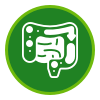
Ulcerative Colitis (UC)
Medical history11
The first step in the diagnosis of Ulcerative Colitis (UC) involves taking a full medical history including information around when your symptoms first started, what medication you have taken, family history, etc.
Examination11
The second step is a physical examination that includes general well-being, body temperature, blood pressure, abdominal tenderness etc. A stool sample examination to check for signs of infection, a full blood test, liver function tests and others to check for inflammation in your body are also performed.
Diagnosis1819
Two further tests are performed to determine the cause of the symptoms and establish a diagnosis: a tissue sample from your colon and a colonoscopy. A colonoscopy is a non-surgical procedure where a physician inserts a thin, flexible tube that contains a tiny video camera into the rectum which allows him/her to view the inside of your colon.
Imaging tests, including computer tomography (CT), magnetic resonance imaging (MRI) or ultrasound, can also be used to aid diagnosis and help monitor the disease.

Crohn’s Disease (CD)
Because the inflammation in Crohn’s Disease (CD) can occur anywhere along the gastrointestinal tract (GI) and its symptoms can look like those of other conditions (e.g. ulcerative colitis), the diagnosis of CD can be somewhat complicated. Therefore, your physician will most probably perform a combination of tests and procedures.
Medical history14
The first step in the diagnosis of CD involves taking a full medical history including information around when your symptoms first started, what medication you have taken, family history, etc.
Examination1415
The second step is a physical examination that includes heart rate, blood pressure, an abdominal
examination, and other symptoms beyond those limited to the gastrointestinal tract (e.g. in the eyes, skin, joints and muscles). A full blood test and other tests to check for inflammation in your body (e.g. C-reactive protein (CRP) and faecal calprotectin (FC)) are also performed.
Diagnosis1415
Two further tests are performed to determine the cause of the symptoms and establish a diagnosis: a tissue sample from your colon and an endoscopy. An endoscopy is a non-surgical technique that can involve either a) the insertion of a long, flexible tube (endoscope) through the mouth or the anus depending on where the doctor wants to look that contains a tiny video camera, or b) the patient swallowing a tiny camera.
Imaging tests, including computer tomography (CT), magnetic resonance imaging (MRI) or ultrasound, can also be used to aid diagnosis and help monitor the disease.

My IBD Journey offers guidance on how to plan and manage the range of symptoms you may encounter as an individual living with Inflammatory Bowel Disease (IBD), allowing you to live your life to the fullest.
